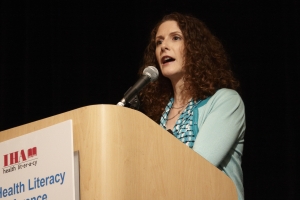February 11
A Patient’s Perspective on the Health Literacy Myth
0 comments

How do you prepare to be a patient? This is the question that Maria Ross, a college-educated business owner with an interest in acting, asked her audience. The story she told of her brain aneurysm and recovery was ample proof that you can’t. Her point was that we can do a better job of helping the health care system understand what it is like to be a patient. Her talk, she said, would be about patient care versus patient processing.
A common thread ran through Ross’s story about the weeks she spent in intensive care, months of therapy and home care, and against the odds, her recovery. It was the sensation that she had “dropped into a foreign language.” The doctors had saved her life, but she and her family struggled to understand what that life would be like. She recognized through her experience, that ongoing maintenance and abilities for self care are what patients need, just as much if not more than the medical prowess that saved their lives. She quoted Lori McKitrick , a speech therapist at the Survivorship Training and Rehab (STAR) program, Greenville, S.C “In a lot of hospitals you will see patients fall through the cracks after surgery….We are doing a great job saving people’s lives but we have to help them live their lives, too.” (WSJ, Jan 2013)
This recognition has led her to teaching health literacy skills like teach back and serving as a Patient Advisor at the University of Washington Medical Center. Among her recommendations: ditch the jargon. The hospital is your world not ours. What’s common knowledge in your business, your tribe, is not in ours. We all take for granted that “our world” is everywhere. Similarly she advised providers to understand the patient’s context. She recalled the story of a person who came to her home during the recovery process to deliver resources for the blind. Though she had successfully undergone surgery to reverse blindness resulting from the aneurysm, she was not, at that point, blind. The person dismissed this context, and did what he felt was his job to do — he delivered those resources.
Ross reminded the audience that silence is not golden, nor is “yes.” Patients need to ask for information to be repeated and to ask questions like “what do you hope to find out from this test?” Providers need to be looking at questioning as a sign of engagement, like taking notes. Don’t assume that patients have been told something — either by another person, or by you. Use checklists and scripts so you can be sure you’ve said what needs to be said, and recommend reference materials. And get creative — use teaching aids, written materials, and 3-D models. One of the memories she has retained, in spite of the fact that it happened when she had difficulty with short-term memory, was an explanation given by a provider who used a model.
The recommendations Ross offered were clear and simple and perhaps familiar to many in the audience, but particularly acute in the context of her story. She pointed out that according to the U.S. Department of Health and Human Services, “Nearly 9 out of 10 adults have difficulty using the everyday health information that is routinely available in healthcare facilities, retail outlets, media and communities” (2011). This ratio, she said, would be considered an abysmal failure in any other industry. Familiarity with solutions does not mitigate our need to implement them.
Tags